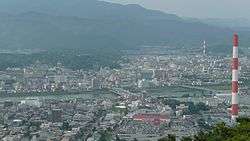Nobeoka, Miyazaki
Nobeoka (延岡市, Nobeoka-shi) is a city located in the north of Miyazaki Prefecture, Japan.
Nobeoka {ja} | |
|---|---|
 Panorama view of Agata and Nakashima, other downtown areas and the Ose River in Nobeoka, from Mount Atago. | |
 Flag  Chapter | |
 Location of Nobeoka in Miyazaki Prefecture | |
 Nobeoka Location in Japan | |
| Coordinates: 32°35′N 131°40′E | |
| Country | Japan |
| Region | Kyushu |
| Prefecture | Miyazaki Prefecture |
| Government | |
| • Mayor | Masaharu Sudō |
| Area | |
| • Total | 868.02 km2 (335.14 sq mi) |
| Population (June 1, 2019) | |
| • Total | 119,521 |
| • Density | 140/km2 (360/sq mi) |
| Symbols | |
| • Tree | Round Leaf Holly (Ilex rotunda) |
| • Flower | Canna |
| • Flowering tree | Wisteria |
| Time zone | UTC+9 (JST) |
| City hall address | 2-1 Higashihonkōji, Nobeoka-shi, Miyazaki-ken 882-8686 |
| Website | www |
As of the June 1, 2019, the city has an estimated population of 119,521[1] and a population density of 138 persons per km². The total area is 868.02 km².
History
The city was officially founded on February 11, 1933, after it gained city status. During World War II, it was one of the most important centers of military explosives in Japan.[2] On the night of June 28-29th, 1945, 117 United States B-29s fire-bombed the city, destroying 1.35 square km, or 36% of the city.[3] On July 16, 1945, 33 US B-24s bombed the bridges in around the city, severing the strategically important Nippō Main Line railway.[4]
On February 20, 2006, Nobeoka absorbed the towns of Kitakata and Kitaura (both from Higashiusuki District).
On March 31, 2007, the town of Kitagawa (also from Higashiusuki District) was also merged into Nobeoka.
Climate
Nobeoka has a humid subtropical climate (Köppen climate classification Cfa), which is hot and humid in the summer (above 30 °C (86 °F)) and is somewhat cold in the winter with temperatures dropping to around freezing (0 °C (32 °F)). Snowfall can be seen in the winter months, but does not accumulate because of coastal warming effects.
| Climate data for Nobeoka (1981-2010, elevation 192 m (630 ft)) | |||||||||||||
|---|---|---|---|---|---|---|---|---|---|---|---|---|---|
| Month | Jan | Feb | Mar | Apr | May | Jun | Jul | Aug | Sep | Oct | Nov | Dec | Year |
| Record high °C (°F) | 23.5 (74.3) |
26.1 (79.0) |
29.7 (85.5) |
29.6 (85.3) |
33.3 (91.9) |
36.0 (96.8) |
38.5 (101.3) |
38.4 (101.1) |
35.2 (95.4) |
32.5 (90.5) |
29.5 (85.1) |
23.3 (73.9) |
38.5 (101.3) |
| Average high °C (°F) | 12.4 (54.3) |
13.5 (56.3) |
16.2 (61.2) |
20.8 (69.4) |
24.1 (75.4) |
26.5 (79.7) |
30.3 (86.5) |
31.2 (88.2) |
28.5 (83.3) |
24.2 (75.6) |
19.3 (66.7) |
14.6 (58.3) |
21.8 (71.2) |
| Daily mean °C (°F) | 6.6 (43.9) |
7.7 (45.9) |
10.7 (51.3) |
15.3 (59.5) |
19.1 (66.4) |
22.3 (72.1) |
26.1 (79.0) |
26.7 (80.1) |
23.8 (74.8) |
18.7 (65.7) |
13.5 (56.3) |
13.5 (56.3) |
16.6 (61.9) |
| Average low °C (°F) | 1.5 (34.7) |
2.5 (36.5) |
5.7 (42.3) |
10.2 (50.4) |
14.6 (58.3) |
18.8 (65.8) |
22.7 (72.9) |
23.2 (73.8) |
20.1 (68.2) |
14.2 (57.6) |
8.7 (47.7) |
3.4 (38.1) |
12.1 (53.8) |
| Record low °C (°F) | −7.2 (19.0) |
−6.6 (20.1) |
−3.9 (25.0) |
−1.7 (28.9) |
4.2 (39.6) |
10.2 (50.4) |
14.7 (58.5) |
16.5 (61.7) |
8.6 (47.5) |
3.0 (37.4) |
−2.4 (27.7) |
−5.5 (22.1) |
−7.2 (19.0) |
| Average precipitation mm (inches) | 53.7 (2.11) |
74.1 (2.92) |
164.3 (6.47) |
214.5 (8.44) |
242.9 (9.56) |
354.3 (13.95) |
264.4 (10.41) |
269.8 (10.62) |
334.8 (13.18) |
180.0 (7.09) |
94.6 (3.72) |
50.3 (1.98) |
2,292.1 (90.24) |
| Average relative humidity (%) | 63 | 63 | 67 | 70 | 76 | 83 | 83 | 82 | 80 | 74 | 72 | 66 | 73 |
| Mean monthly sunshine hours | 188.6 | 172.4 | 173.7 | 183.3 | 179.7 | 137.1 | 194.2 | 202.2 | 157.6 | 177.9 | 166.8 | 191.3 | 2,125.2 |
| Source 1: Japan Meteorological Agency[5] | |||||||||||||
| Source 2: Japan Meteorological Agency[6] | |||||||||||||
Economy
The city's economy depends strongly on the company Asahi Kasei, a producer of synthetic and industrial fibers. It is known regionally for its Ayu fish.
Transportation
Nobeoka is the terminal station for trains that run the length of the prefecture (although some trains do continue up into Ōita prefecture). It used to be the terminal station for the privately owned Takachiho line, which ran towards Kumamoto prefecture from the northeast to the northwest of the prefecture. This line was closed after a typhoon in 2005, and has not been reopened.
Nobeoka is serviced by the Higashikyushu Expressway which brings transportation time to Miyazaki City down to one hour and travel time to Ōita City down to about 1 hour 30 minutes.
Nobeoka has its own municipal bus service with routes to most destinations in the city.
References
- "Japs Disperse War Plants" , The Argus, Melbourne, June 30, 1945.
- "Official website of Nobeoka Town" (in Japanese). Japan: Nobeoka Town. Retrieved 27 April 2017.
- http://nla.gov.au/nla.news-article970734
- http://www.pacificwrecks.com/60th/1945/6-45.html
- "Archived copy". Archived from the original on 2010-10-05. Retrieved 2010-08-14.CS1 maint: archived copy as title (link)
- 延岡 年・月ごとの平年値 (in Japanese). 気象庁. Retrieved 2018-04-07.
- 延岡 観測史上1~10位の値 (in Japanese). 気象庁. Retrieved 2018-04-07.
External links
- Nobeoka City official website (in Japanese)
- Nobeoka City official website (in English)